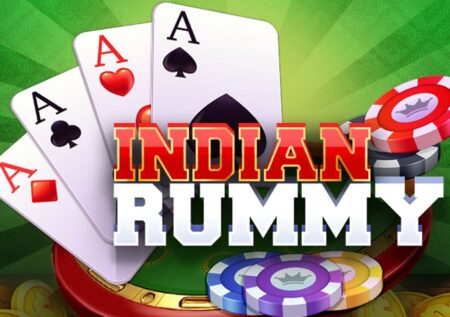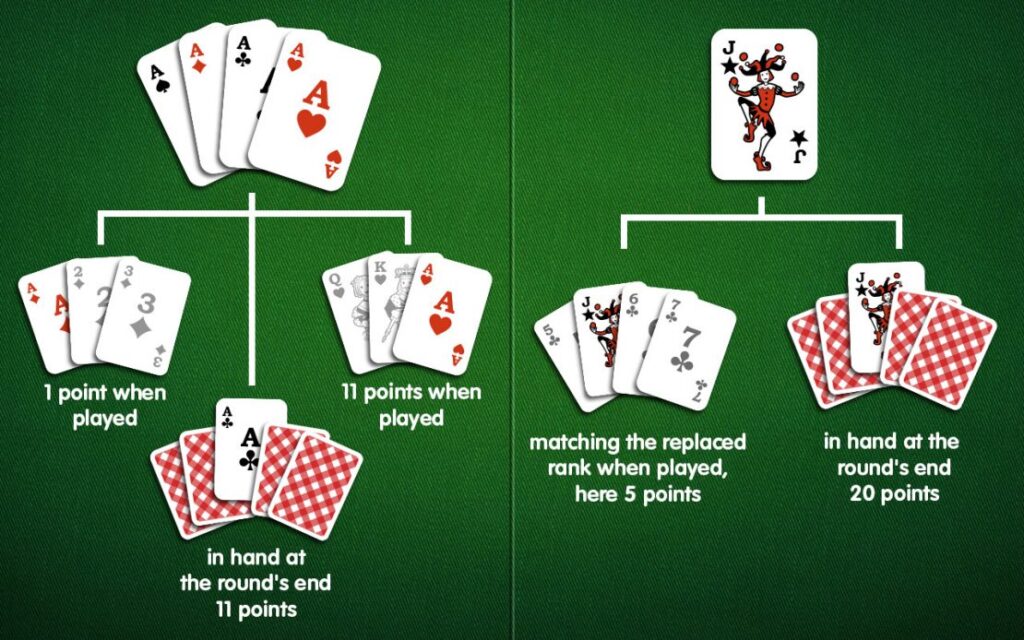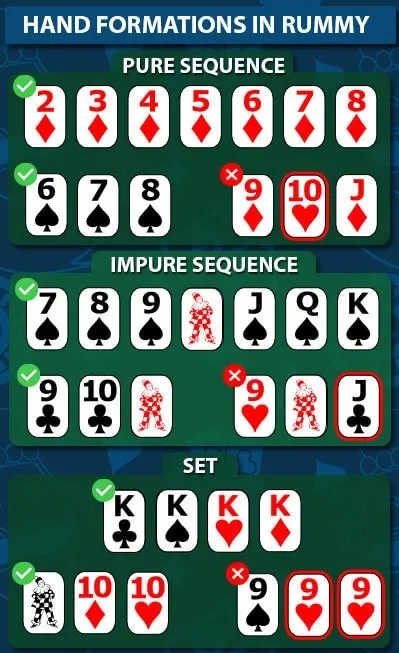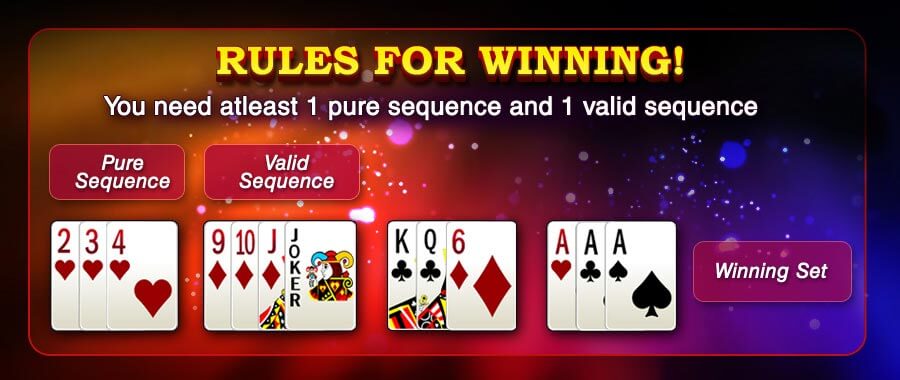

Rummy is one of the most popular card games around the world, with millions of people enjoying it in their spare time. Playing Rummy online has quickly become a way for many to test their skills and compete against others from all over the globe. As such, knowing how to play Rummy and win can be an important part of having a successful time with the game.
This guide will provide you with some helpful tips and tricks on how to improve your chances of winning when playing Rummy online. By learning about strategies, bluffing techniques, and other advanced tactics, you can raise your game to a higher level and have more fun at the same time. Whether you’re already an experienced Rummy player or just getting started, taking advantage of these tips can help you get ahead in this classic game.
Rummy is a game of skill, strategy, and luck that often involves more than two players. The objective of the Rummy card game is to be the first player to form valid sets and sequences from their hand of cards. Sets are three or four cards of the same rank, while sequences are three or more cards in sequence in the same suit. To win a hand, players must meld a number of these valid sets and sequences before their opponents to reach 100 points.
The strategic element comes into play as players have to decide when to meld one set or sequence versus holding on for future melding options or games with other players. Players will also need to pay attention to what their opponents meld as they might be able to use those same cards in their own hands. Additionally, playing jokers can sometimes be advantageous but it’s important to remember that the joker cannot be used as an Ace in any circumstance; only being able to replace another card with its rank and suit.
The luck element comes into play when dealing the hands and drawing from the pile. Sometimes there simply isn’t enough time for you to form all your sets and sequences before someone else goes out – this is where luck plays a part! And even if you don’t manage to go out first, winning enough points during each round can still mean an overall victory at the end of the game!
Rummy is a card game typically played with two decks of cards. Players sit around a table and take turns drawing and discarding cards, with the goal of forming melds, or sets of cards of the same rank or sequence. The first player to meld all of their cards, or with the lowest score if no one has melded, wins the hand.
There are a few different ways to play Rummy, but the most common is Draw Rummy. In this version of the game, each player is dealt 7 cards. They then look at their hand and decide which card to discard. The aim is to form melds – either sets (e.g. 3 kings) or runs (e.g. 4, 5, 6 of Hearts).
A player can also add to other players’ melds if it helps them form their own. Once a player has formed valid melds with all of their cards, they lay them down on the table and discard one final card. The other players then continue drawing and discarding until they can lay down their own melds. The first player to go out wins the hand.

To begin the game, the dealer must first deal out the cards to each player. The amount of cards dealt depends on how many players are in the game and typically varies between two and six players.
The most common way to deal in Rummy is by having each player draw one card at a time until all of the cards have been dealt out. After all of the cards have been given to each player, they should be arranged in their respective hands according to suit and rank, starting with the ace being highest followed by kings, queens, jacks, ten’s etc., down to two’s which are considered the lowest ranked cards. It is also common for some versions of Rummy to include wildcards which can represent any other rank or suit depending on what type of Rummy you are playing.
Once all of the players have their hands sorted it is time for them to decide on what type of melds they would like to form and begin playing their turns based off of that strategy. A meld is a set or sequence combination made up from three or more cards from their own hand. These melds generally consist of either sets (three or four cards that are equal in rank) or sequences (three or more consecutive cards). When forming a sequence it is important to note that if you are playing with wildcards these can only replace one card at a time; not multiple in a row.
The goal of the game is to form matched sets and sequences from the cards in your hand. To win, you must be the first player to discard all the cards in your hand by forming valid combinations from them.
Playing Rummy involves drawing and discarding cards as well as knowing which cards can be combined together for a valid set or sequence. A set consists of three or four cards of the same rank, while a sequence consists of three or more consecutive cards in a suit. Jokers are wild and can represent any card when used to form a set or sequence. During each turn, players draw either from the face-down stock pile or the top card from the discard pile, then they form sets and sequences with their own cards before discarding one onto the discard pile.
The round ends when no more moves can be made and one player has managed to get rid of all their cards. At this point, points are tallied up based on how many unmatched cards remain in other players’ hands. The player who reaches a predetermined score first wins.
There are a lot of different ways to play Rummy, but the basic idea is to form melds, lay off cards, and discard.
Melds are sets or runs of cards, like three or four of a kind, or a sequence of three or more cards in the same suit. To form a meld, you just need to have the right cards in your hand. There’s no need to put them down on the table until you’re ready to lay them off or discard them.
Laying off is when you add cards to an existing meld. For example, if someone lays down a run of three clubs (9-10-J), and you have the Ace and King of clubs in your hand, you can lay them off on that run.
Discarding is when you get rid of a card that you don’t need. You can discard at any time, but you can only draw from the stock once per turn, so it’s usually best to wait until you have a good card to throw away.
Scoring in Rummy is one of the core elements that makes the game so enjoyable. The basic objective is to create melds out of cards, either groups or runs, and score points based on those melds. Points are awarded for completing sets and runs of 3 or more cards, with higher scoring the longer the set or run. To win the round, you must be the first player to collect 100 points by forming melds.
The traditional scoring system in Rummy follows what’s known as the “First Meld Rule”. In this system, each player starts off with zero points at the beginning of each round. When it comes their turn, they can choose to make an initial meld if they have enough cards in hand that satisfy that criteria (e.g., two three-card sequences). If they do succeed in forming a valid meld then they receive an additional 20 points to their score. This gives them an advantage over other players who haven’t made a meld yet since they get to accumulate points earlier than them.
Players can also gain extra bonus points when making certain special moves during a round such as going out (when all your cards have been laid down) or laying down all 7 cards from one suit in one go into 2 different melds called a “seven grand” or “big gin”. All these bonuses add up throughout a game and can mean the difference between winning or losing at the end of each round.
The goal of the game is to meld all of the cards in your hand into sets or runs. Sets are three or four cards of the same rank, such as three kings or four aces. Runs are three or more cards of consecutive rank, such as 4-5-6 or 8-9-10-J. Once you have melded all of your cards, you can declare rummy and win the hand.
There are a few different ways to play rummy, but the most popular version is draw and discard. In this version, each player is dealt a hand of cards. The remaining cards are placed face down in the middle of the table, forming the draw pile. The top card of the draw pile is turned over to begin the discard pile.
Players take turns drawing a card from either the draw pile or the discard pile and then discarding one card. If the card you draw allows you to meld, you may do so immediately. For example, if you draw a 9 and already have a 4-5-6 in your hand, you could meld the 9 with the 5 and 6 to form a run. Alternatively, if you draw an ace and already have two other aces in your hand, you could meld all three aces to form a set.
If the card you draw does not allow you to meld, you must simply discard it onto the discard pile. Play then passes to the next player who repeats this process. The game continues until one player has melded all of their cards and declared rummy!

Unfortunately, there have been cases where people have engaged in wrong declarations during the game of rummy which can lead to serious consequences for those involved.
A wrong declaration or false declaration occurs when someone claims to have a winning hand but does not actually meet the criteria for winning. This could be due to an oversight or lack of knowledge about the rules of rummy, but either way it is considered a breach of the regulations governing the game and can lead to penalties being imposed on those responsible. For instance, in some jurisdictions such as India, making a wrong declaration can result in fines or even imprisonment for those who are found guilty. In addition, if false declarations are made in certain types of tournaments they may result in disqualification from the event altogether.
The first step in building an effective rummy strategy is learning how to evaluate your hand. You should pay attention to what cards are currently in play so you can determine which combinations are possible for you and your opponents. This will also help you identify opportunities for discarding weak cards or forming sets and runs that will increase your points.
Another key element of any successful rummy strategy involves managing your melds effectively. You should keep track of which sets and runs are already on the table, as well as which cards have been discarded by other players. By paying careful attention, you can set yourself up for success by creating combinations that no one else has thought of yet. Additionally, make sure to keep an eye out for opportunities for quick point gains with minimal risk, such as making multiple melds from one draw or going out early in the round with a low-point hand.
Finally, never underestimate the importance of luck when playing rummy — sometimes no matter how strong your strategy is, you won’t be able to pull off the perfect hand without some good fortune! However, with careful observation and strategic thinking, you have a much better chance at winning than if you just rely on blind luck alone.

When it comes to setting the number of rounds for a game of rummy, it is important to choose an amount that will be enjoyable and provide enough time for players to strategize. Typically, rummy can be played with anywhere from two to ten players, and each round should last between 15 to 30 minutes. Depending on the amount of players and the desired length of playtime, the number of rounds can be adjusted accordingly.
For example, if playing with two people, 3-4 rounds should suffice. For a five-player game, 7-8 rounds should provide the right balance of competition and playtime. When playing with eight or more participants, 10-12 rounds are usually necessary in order to ensure that everyone gets enough turns and opportunities to win. It’s also important to note that some variations of rummy have additional rules regarding the maximum or minimum number of rounds allowed in any given game.
More than one meld during the course of the game can be a great way to add excitement and strategy to the game, and it can also be a lot of fun. There are a few different ways to do this, but one of the most common is to simply allow players to form additional melds whenever they can. This can be done with any number of cards, and it can really add a lot of depth to the game. Another way to do this is to allow players to form multiple melds at once, which can be a great way to speed up the game.
Laying off before melding in Rummy is a strategic move that can give players an advantage. By discarding cards that are not part of a player’s initial hand, they can reduce the number of points they will ultimately score. This is especially useful when playing against opponents who are likely to meld their hands, as it can reduce the amount of points they will score.
There are a few things to keep in mind when considering this strategy. First, it is important to only discard cards that will not be useful in forming a meld. This means that it is usually best to discard high-value cards, as they are less likely to be part of a productive meld. Second, it is important to pay attention to the opponent’s discards, as this can give clues as to what cards they are holding and what melds they are working on. Finally, it is important to remember that this strategy is only effective if the opponent does not also lay off before melding.
In ‘Aces High’ Rummy version, Aces are treated as high cards, and can be used to complete certain combinations during the game play. This means that Aces can be used to form sets or runs instead of just counting as 1 point.
In a standard Rummy game, players draw and discard cards from the deck in order to form melds or sets consisting of three or four of a kind (like four 5s or six 8s) or runs (such as 4-5-6). If a player is able to make all 11 of their cards into valid melds and runs, they have achieved a ‘Rummy’. However, when playing Aces High, an Ace may also be used as part of a run; for example: 5-6-7-8-Ace. This makes it slightly more challenging since players need more strategic decisions when deciding which combinations they will attempt to create with their hand.
Playing Aces High requires some tactical thinking and careful consideration when selecting which combination will give you the most points at any given time. Additionally, it adds an extra layer of excitement to the game since any Ace could potentially become part of a winning strategy in the endgame. It also encourages players to stay focused on all possible combinations throughout the game as even small cards like 2s and 3s may unexpectedly turn into an Ace if drawn from the deck.
Jokers are typically wild cards, meaning they can substitute for any other card in the deck when forming melds. This makes them incredibly valuable during gameplay, as players can use Jokers to finish runs or sets that would otherwise be impossible.
When using a Joker in a meld, it’s important to remember that its point value is zero. This means that even though it can be used to help complete high-value melds, it will not add anything to the total points of those melds. This means that if playing with points, it’s best to try and keep track of which cards have been discarded so far in case a Joker becomes useful later on in the game.
Another important thing to note about using Jokers is that each player is only able to use one at a time per turn. Furthermore, two Jokers cannot be used together in one meld – they must either be replaced with real cards or saved for another turn instead. Keeping this rule in mind will help players maximize their use of the wild card over multiple turns.
This Rummy rule implies that players cannot safely get rid of their cards by discarding them until they’ve already given away all their other cards. Since it is important to get rid of all your cards as quickly as possible to win, having the option to discard your last card can be a real advantage.
This rule also helps add an element of strategy to Rummy; since players are unable to discard their last card until they have already discarded all their other cards, they must think carefully about which moves they make throughout the game in order to ensure they don’t discard the wrong thing or end up with too few remaining options at the end. This means that a skilled player will have an edge over someone who is less experienced with the game’s mechanics.
Finally, discarding your last card does not mean you automatically win – rather, it just allows you to keep playing without having any more cards left in your hand, as long as you’re able to form more sets or runs with what your opponents may be discarding.
Reusing the discard pile in rummy is a popular alternative to the traditional method of playing, which requires players to draw from the deck exclusively. This variant gives players more control over their hand, as they can draw from either the deck or at any time during their turn they can take the top card on the discard pile and use it in their hand. The player who takes a card from the discard pile must then immediately discard one of their own cards, continuing this cycle until all 13 cards are used in melds or until no more moves can be made.
Unlike other versions of rummy that only allow for certain conditions for reusing the discard pile (such as having an exact match in your hand), this version allows for any combination of cards as long as it follows valid rummy rules. By being able to utilize multiple combinations when playing with a discard pile, players enjoy increased probability of forming melds and other winning hands, resulting in a more strategic game overall.
The reuse of the discard pile has become especially popular among experienced players who are used to drawing haphazardly from the deck. With this new approach to play, these players have an extra option that they can use to increase their chances of getting winning combinations or even maximize points by discarding low-value cards when taking others from the discard pile.
Each round of Rummy features a unique scoring system that rewards players who construct valid combinations and sequences out of their cards. For example, certain points are awarded for each group or sequence created; the more complex the combination, the higher the points rewarded. Special hands like “going rummy” (creating an entire set sequence in one turn) or “shutting out” (preventing an opponent from going out) yield even greater rewards.
The point values of particular combinations within a game of Rummy can vary from house to house, so it is important to read up on these details before playing. Additionally, some versions may also include additional rules such as bonuses for making multiple melds in a single turn or subtracting points for leaving unmatched cards at the end of a hand.
In order to win a game, players must strive to create as many high-scoring combinations as possible while trying not to accumulate too many negative points. This requires strategizing and careful planning throughout every stage of the game in order to maximize point totals and emerge victorious.
Here is a list of common vocabulary used in Rummy:
Yes, playing rummy is legal in India with certain conditions.
Yes, Rummy can be played with 2 or more players.
Typically, each player is dealt 13 cards in Rummy.
To start a game of Rummy, the deck is shuffled and dealt to each player, the top card from the remaining deck is placed face up to start the discard pile, and the remaining cards are placed face down to start the stock pile.
In Indian Rummy, a joker is worth zero points.
The number of jokers in Rummy depends on the specific rules of the game, but it is usually 2 or 4.
Rummy is a game that requires both skill and luck. A player must be able to form sets and runs of cards, but also rely on the luck of the draw to obtain the necessary cards.
There is no set number of sets that must be formed in Rummy. The objective is to form as many sets and runs as possible and get rid of all the cards in one’s hand.
The Rummy game settles when a player has melded all the cards in their hand and has discarded the last card. The winner is typically the player with the lowest score.